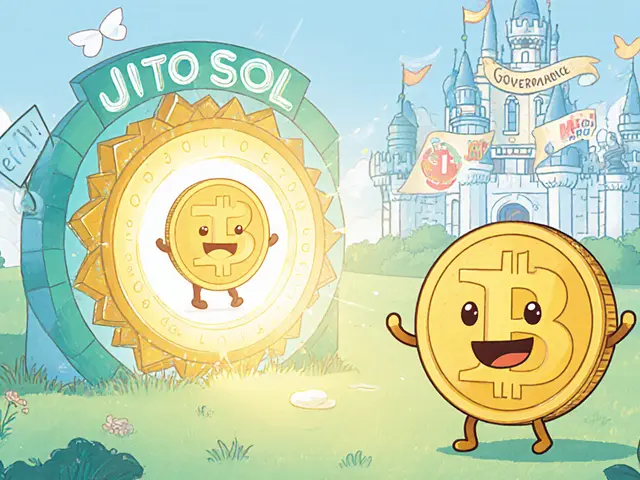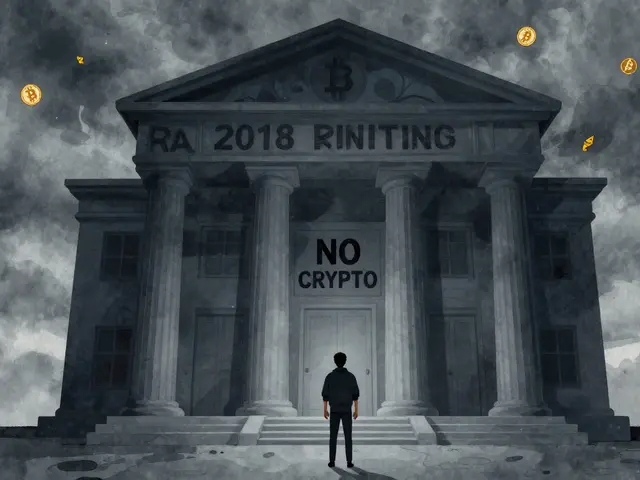Jito (JTO) Yield Calculator
Estimated Annual Returns
Total APY: 0.00%
Base Staking Return: $0.00
MEV Profit: $0.00
JTO Governance Reward: $0.00
Total Annual Return: $0.00
Daily Return: $0.00
Quick Summary
- Jito token (JTO) is the governance token of Jito Network, Solana’s leading liquid‑staking and MEV protocol.
- Stake SOL via JitoSOL to earn standard staking rewards plus extra MEV profit.
- Revenue split: 50% to SOL stakers, 40% to JTO stakers, 10% to the treasury.
- Jito holds about 63% of Solana’s liquid‑staking market and $1.2B TVL (Oct2024).
- Getting started only takes 8‑12minutes; advanced validator setup needs ~16hours.
What Is Jito (JTO) Token?
When you hear people talk about Jito token (JTO), they’re referring to the governance token that powers the Jito Network. Launched in December2023, the network was built by the Jito Foundation to solve two problems on Solana: the lack of liquid staking options and the inefficiency of extracting Maximum Extractable Value (MEV).
How Jito Network Works
The core of the ecosystem is Jito Network. It runs an open‑source validator client that runs a block‑wide auction. Searchers submit bids to reorder transactions, and the highest‑paying bids win the right to place MEV‑rich trades inside a block. The captured MEV is then split among participants, giving stakers a boost over plain Solana staking.
All of this happens while you hold JitoSOL, a liquid staking token that stays 1:1 pegged to SOL. When you deposit SOL, you instantly receive JitoSOL, which you can trade, use as collateral, or keep in a wallet. Under the hood, JitoSOL earns the regular Solana staking yield (around 5‑7% APY) plus the extra MEV share.
Yield Mechanics: Staking + MEV
Historically, JitoSOL’s APY has floated between 7% and 12% - noticeably higher than the 5‑7% you’d get from a plain validator. That extra bump comes from the MEV revenue split. Here’s how the pie is cut:
- 50% goes straight to SOL stakers (the people who lock SOL into JitoSOL).
- 40% is routed to JTO stakers - that’s why holding JTO can sweeten your overall return.
- 10% funds the Jito treasury for future development and community grants.
Because the protocol captures roughly 90% of Solana’s total transaction volume, the MEV pool is sizable. During volatile market weeks, arbitrage opportunities between DEXs like Orca and Raydium can surge 300‑400%, which directly pumps the MEV side of the yield.
Market Position & Competition
Jito isn’t the only player in the Solana liquid‑staking space, but it dominates. DefiLlama data (Oct2024) shows a 63% market share, dwarfing Marinade (22%) and Everstake (9%). The differentiator is the built‑in MEV engine - competitors simply offer “staking‑only” solutions.
| Protocol | Market Share | MEV Integration | Avg. APY |
|---|---|---|---|
| Jito | 63% | Yes (block‑wide auction) | 7‑12% |
| Marinade | 22% | No | 5‑7% |
| Everstake | 9% | No | 5‑6% |
While Jito’s efficiency boost (15‑20% better MEV capture) is a clear advantage, it also means roughly 45% of Solana’s validator set now runs a Jito‑optimized client - a concentration risk that regulators and critics keep pointing out.
Risks, Criticisms & Regulatory Outlook
Every new protocol faces pushback, and Jito is no exception. Chainalysis’s chief scientist warned that the MEV auction model can give sophisticated actors a disproportionate edge, potentially creating a new kind of centralization. Moreover, the SEC’s September2024 staff letter hinted that liquid‑staking tokens might be deemed securities depending on how they’re marketed, which puts JitoSOL under a compliance microscope.
Other practical risks include:
- Withdrawal delays during network congestion (users report 1‑2day queues).
- Fee complexity - the dynamic fee structure introduced in Oct2024 can be confusing for newcomers.
- Dependency on Solana’s health - 40% of Jito’s value correlates directly with SOL price performance.

Getting Started: A Simple Step‑by‑Step Guide
- Set up a Solana‑compatible wallet (Phantom, Solflare, or Ledger). No minimum stake is required.
- Navigate to the official Jito staking portal (search “Jito staking” to avoid phishing).
- Connect your wallet and deposit the amount of SOL you wish to stake.
- Receive an equal amount of JitoSOL instantly - issuance takes under 5seconds.
- If you want exposure to MEV revenue, stake your JTO tokens in the governance vault (found on the same dashboard).
- Monitor earnings via the built‑in MEV Dashboard, which shows real‑time profit breakdowns.
For users comfortable with running a validator, Jito’s GitHub outlines a hardware spec of 128GB RAM, an 8‑core CPU, and a 1TB NVMe SSD. The setup process averages 16hours, including software install and test‑net runs.
Future Roadmap: What’s Coming Next?
Jito isn’t standing still. The recent v2.1 upgrade (Sept2024) trimmed MEV extraction latency from 400ms to 220ms, meaning faster order‑matching and higher revenue per block. The community’s latest governance proposal (Oct12024) aims to introduce a dynamic fee that rises when the network is congested, protecting validators from overload.
Looking ahead, the roadmap includes:
- Jito Chain - a Solana L2 dedicated to MEV processing, slated for Q12025.
- JitoPay - a payment routing layer that squeezes MEV profit from everyday crypto transactions, expected Q22025.
- Cross‑chain liquidity pools (Q42025) to bring Jito’s MEV engine to Ethereum, BNB Chain, and others.
Key Takeaways for Different Readers
- Retail staker: Use JitoSOL for higher yields but keep an eye on withdrawal queues.
- Validator operator: Consider running a Jito‑optimized node for extra MEV rewards; expect a steep hardware cost.
- Institutional investor: Allocate to JTO for governance influence and additional revenue streams, but monitor whale concentration (top10 wallets hold 58% of voting power).
Frequently Asked Questions
What is the difference between JitoSOL and regular SOL staking?
JitoSOL is a liquid token that stays pegged 1:1 to SOL while automatically funneling MEV profits back to holders. Regular SOL staking locks the asset and only earns the base network reward.
How can I earn JTO rewards?
Stake JTO in the governance vault on the Jito dashboard. The vault distributes 40% of the captured MEV revenue to JTO stakers, usually on a daily basis.
Is Jito safe during Solana network outages?
Jito’s contracts are open‑source and have been audited by multiple firms. However, because 40% of its value is tied to SOL performance, a prolonged SOL outage would impact both staking yields and MEV capture.
Do I need technical knowledge to use Jito?
No. The basic staking flow works with any standard Solana wallet and takes less than 10minutes. Running a validator does require familiarity with Rust, Linux, and server provisioning.
What are the main risks of holding JTO?
Risk factors include concentration of voting power among a few whales, possible SEC classification of JitoSOL as a security, and reliance on Solana’s overall health. Diversifying across other staking protocols can mitigate some of these concerns.









angela sastre
October 10, 2025 AT 11:43Aniket Sable
October 11, 2025 AT 05:52Santosh harnaval
October 12, 2025 AT 05:25Mike Kimberly
October 12, 2025 AT 20:43Patrick Rocillo
October 13, 2025 AT 00:18Will Atkinson
October 13, 2025 AT 13:40Edwin Davis
October 14, 2025 AT 00:14emma bullivant
October 14, 2025 AT 04:07Michael Hagerman
October 14, 2025 AT 14:39Laura Herrelop
October 14, 2025 AT 14:53Nisha Sharmal
October 15, 2025 AT 08:12Karla Alcantara
October 16, 2025 AT 07:03Jessica Smith
October 16, 2025 AT 10:41Petrina Baldwin
October 16, 2025 AT 11:14Claymore girl Claymoreanime
October 17, 2025 AT 00:12Ralph Nicolay
October 17, 2025 AT 15:28monica thomas
October 17, 2025 AT 23:20